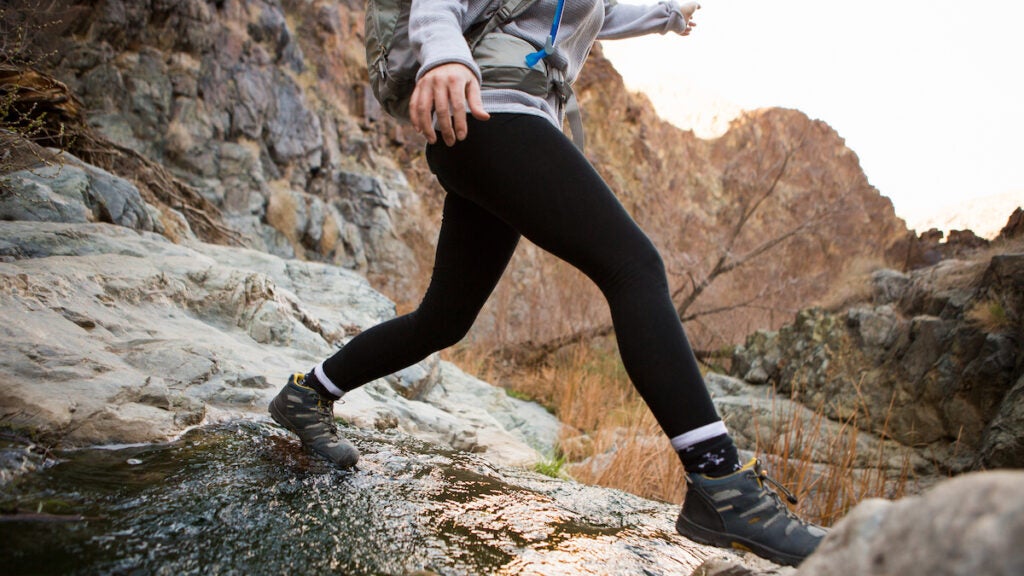



For the most part, my joints have withstood all the type 2 fun I’ve thrown at them throughout the years, but there’s one nagging pain that reliably flares up on every backpacking trip. On my last overnight, I lay wide awake on my sleeping pad while my hips throbbed like a metronome. I counted pulses of pain (instead of sheep) hoping it would lure me to sleep, but instead, I worried if I would be too stiff to crush the hills we expected to climb the next day.
Your hips are essential to your ability to hike. Most of the muscles around the hip joint are engaged when you’re walking or hiking. That being said, hip soreness or ache is one of the most common backpacking ailments. That’s likely because there are many possible causes. Here are a few, and how to fix them.
An ill-fitting pack throws everything out of whack. Make sure yours fits properly so you’re not pinching the IT band, which runs along the femur from the outside of the hip to the outside of the knee. If your hip belt sits too low and puts pressure on this band, the fascia tissue can get aggravated and grow tight over time. Your backpack should sit at the top of your hips, which is known as the iliac crest, to prevent hip pain.
Sometimes, the pain isn’t related to your gear; it’s more of an issue with biomechanics, such as how you walk. When you hike, your feet either stay neutral, pronate, or supinate. Ideally, your feet land directly on the soles, but many people favor either side of their heel with each step. Pronation happens when your foot rolls inward while walking, and supination happens when your foot rolls outward. Pronation is common for people with flat feet, but it becomes an issue when exaggerated—called overpronation. When your feet collapse with each step, your hips can tilt forward, causing muscle imbalances and pain or injury down the line.
Not sure how your foot lands with each step? Take a look at the bottom of your shoes. Overpronated walkers show more wear on the inside of their soles.
Sleeping on a hard surface can wreak havoc on your hips, especially if you’re a side sleeper like me. For a while, I tried to train myself to sleep on my back on backpacking trips, but all that effort would go out the window as soon as I fell asleep. I’d wake up in the middle of the night on my side, with my hips and shoulders crashing through the pad onto the hard ground. Generally, for people with chronic hip pain, inflatable sleeping pads are better than closed-cell foam ones.
There’s a sweet spot of inflation where hips and shoulders can sink into the pad without making contact with the ground. You just might have to spring for a thicker, more cushioned pad. A short-term fix for side-sleepers is to improvise extra cushioning with a clothes-filled stuff sack between your knees to minimize pressure on the joints. Also, back in the day, experienced backpackers would advise creating a small depression in the ground where your hips would otherwise make contact when side sleeping. While we don’t advocate digging holes in the dirt—leave no trace!—moving around loose duff underneath your tent floor can help relieve the aches that can build up overnight.
It’s common to overload your hips while backpacking, especially when your backpack’s too heavy or if you’re not wearing it correctly. This can create tiny tears over time, leading to tendon irritation know as tendinopathy. A common place to feel pain or sensitivity is where the gluteal tendons attach to the femur on the outside of your hip. Tight, weak muscles can contribute to tendon pain, so make sure the muscles surrounding the hips are a part of your strength training regimen.
Muscles and tendons get tight to compensate for weakness surrounding them, so one of the best ways to avoid hip pain is to get strong. Try these five exercises from Lee Welton, physical therapist assistant and personal trainer, to make sure your hips are strong enough to handle every step on the trail.
If you’re not stretched, all of the muscles surrounding your hips can be in a tug-of-war when you hike. Tack on a sedentary workweek where you’re sitting in a position that tightens your hips, and you’ve got a pretty big shock to the body every time you hit the trails.
At the end of every day in the backcountry, give your hips some TLC by stretching them out. Take a little time to stretch your hips and legs before making camp, while your muscles are still warm. Even incorporating periodic stretches during the day, as a part of snack breaks, can make a huge difference in comfort.
Improving mobility in major joints like hips and ankles are great ways to support them on the trail. Incorporate lunge variations, standing pigeon stretches, and leg swings (forward and backward and across your body) into your daily wellness routine.
From 2024

